Do you have a question about the Panasonic SC-AK270 and is the answer not in the manual?
Message to the customer thanking them for purchasing the product and advising to read instructions carefully.
Lists the main unit and speaker models included in the SC-AK270 system.
Lists and identifies all accessories supplied with the system, including part numbers for replacement.
Cautionary notice regarding the use of laser technology in the product and risks of radiation exposure.
Advice to reduce the risk of fire, electric shock, or product damage by avoiding moisture and using recommended accessories.
Contact details for customer care, website for product information, and accessory ordering.
Information on how to properly dispose of electrical and electronic equipment and batteries.
Instructions on proper unit installation, ventilation, and avoiding heat sources or obstructions.
Guidance on the 3-pin mains plug, fuse replacement, and safety if the plug is unsuitable.
Instructions on how to safely replace the fuse in the mains plug, including fuse rating and approval marks.
Explanation of wire colours (Blue/Brown) and their corresponding terminals (N/L) for safe connection.
Warnings about severe electrical shock if a cut-off plug is inserted into a socket, and consulting an electrician.
Guidelines for placing the unit away from heat, humidity, vibration, and ensuring adequate clearance.
Warnings about voltage, AC mains lead protection, foreign matter, and service precautions.
Recommendations for positioning speakers for optimal sound and avoiding magnetic interference.
Instructions on how to connect the speakers to the main unit, noting left/right orientation is not necessary.
Guidance on connecting FM indoor and AM loop antennas for radio reception.
Advice on using outdoor antennas for better radio reception and safety during lightning storms.
Instructions for connecting the AC mains lead, with a specific caution for UK users regarding page 3.
Instructions on how to insert batteries into the remote control, matching polarity, and warnings about battery types.
Tips for aiming the remote control at the sensor and its effective range.
Procedure for safely turning off the unit and disconnecting the mains plug.
Correct method for inserting discs into the tray, ensuring proper placement and handling.
Description of the display panel and the AC supply indicator.
Detailed explanation of the main unit's buttons, including standby, track control, recording, and volume.
Location of the sensor for the remote control.
Explanation of controls like disc tray, volume, cassette holder, and headphone jack.
Explanation of controls in the top, middle, and bottom sections of the remote.
Explanations for Auto Off, Dimmer, and Muting functions.
Instructions on how to open and close the disc tray using the main unit or remote.
How to start playback of a selected disc or track, including selecting other discs.
Functions for stopping, pausing, skipping albums, skipping tracks, and searching.
Steps to cancel the program mode.
How to review the programmed tracks and disc order.
Instructions to clear the last track or all programmed tracks.
Information regarding CD track access, disc types, and handling of discs for optimal playback.
Details on MP3 file treatment as tracks/albums, file system conformity, and naming conventions.
Constraints on MP3 playback, including mixed discs, disc conditions, and recording order.
Instructions for inserting, playing, fast-forwarding, rewinding, and using the Tape Program Sensor.
Guidance on tape selection, preparation, recording sources, and erasure prevention.
How to manually tune to specific FM or AM radio stations.
Procedure for automatically scanning and storing available radio stations.
Tips for improving sound quality, including using MONO for FM and adjusting AM settings.
How to select previously stored radio stations using numeric buttons or preset selection.
Explanation of how the unit displays RDS text data from radio stations.
Instructions for setting the 24-hour clock, which is required for timer functions.
Guide to setting play and record timers, including source selection and time settings.
Details on changing timer settings, source/volume, checking settings, and cancelling timers.
How to select preset sound effects and adjust Bass, Mid, and Treble manually.
Explanation of RE-MASTER and D.BASS functions for enhanced audio.
How to avoid interference and connect portable audio for playback/recording.
Advice on backing up data and not using USB extension cables before connecting a USB device.
Steps to connect a USB mass storage device, reduce volume, and start playback.
Functions for USB pause/resume play, stop play, and skipping tracks or albums.
List of device types compatible with the USB mass storage class.
Information on supported file extensions (.mp3) and file systems (FAT 12/16/32).
Solutions for common unit problems, error codes, and display messages.
Solutions for issues with disc playback, cassette deck, and USB device operation.
Solutions for radio reception issues and disc tray opening errors.
Instructions for memory initialisation and cleaning unit surfaces/cassette heads.
Steps to take before moving the unit to prevent damage.
Details for Amplifier, USB, FM/AM Tuner, Speaker, and Cassette Deck sections.
Information on playable discs, general power, dimensions, mass, and operating conditions.
Information about the manufacturer's website and compliance with EC directives.
Message to the customer thanking them for purchasing the product and advising to read instructions carefully.
Lists the main unit and speaker models included in the SC-AK270 system.
Lists and identifies all accessories supplied with the system, including part numbers for replacement.
Cautionary notice regarding the use of laser technology in the product and risks of radiation exposure.
Advice to reduce the risk of fire, electric shock, or product damage by avoiding moisture and using recommended accessories.
Contact details for customer care, website for product information, and accessory ordering.
Information on how to properly dispose of electrical and electronic equipment and batteries.
Instructions on proper unit installation, ventilation, and avoiding heat sources or obstructions.
Guidance on the 3-pin mains plug, fuse replacement, and safety if the plug is unsuitable.
Instructions on how to safely replace the fuse in the mains plug, including fuse rating and approval marks.
Explanation of wire colours (Blue/Brown) and their corresponding terminals (N/L) for safe connection.
Warnings about severe electrical shock if a cut-off plug is inserted into a socket, and consulting an electrician.
Guidelines for placing the unit away from heat, humidity, vibration, and ensuring adequate clearance.
Warnings about voltage, AC mains lead protection, foreign matter, and service precautions.
Recommendations for positioning speakers for optimal sound and avoiding magnetic interference.
Instructions on how to connect the speakers to the main unit, noting left/right orientation is not necessary.
Guidance on connecting FM indoor and AM loop antennas for radio reception.
Advice on using outdoor antennas for better radio reception and safety during lightning storms.
Instructions for connecting the AC mains lead, with a specific caution for UK users regarding page 3.
Instructions on how to insert batteries into the remote control, matching polarity, and warnings about battery types.
Tips for aiming the remote control at the sensor and its effective range.
Procedure for safely turning off the unit and disconnecting the mains plug.
Correct method for inserting discs into the tray, ensuring proper placement and handling.
Description of the display panel and the AC supply indicator.
Detailed explanation of the main unit's buttons, including standby, track control, recording, and volume.
Location of the sensor for the remote control.
Explanation of controls like disc tray, volume, cassette holder, and headphone jack.
Explanation of controls in the top, middle, and bottom sections of the remote.
Explanations for Auto Off, Dimmer, and Muting functions.
Instructions on how to open and close the disc tray using the main unit or remote.
How to start playback of a selected disc or track, including selecting other discs.
Functions for stopping, pausing, skipping albums, skipping tracks, and searching.
Steps to cancel the program mode.
How to review the programmed tracks and disc order.
Instructions to clear the last track or all programmed tracks.
Information regarding CD track access, disc types, and handling of discs for optimal playback.
Details on MP3 file treatment as tracks/albums, file system conformity, and naming conventions.
Constraints on MP3 playback, including mixed discs, disc conditions, and recording order.
Instructions for inserting, playing, fast-forwarding, rewinding, and using the Tape Program Sensor.
Guidance on tape selection, preparation, recording sources, and erasure prevention.
How to manually tune to specific FM or AM radio stations.
Procedure for automatically scanning and storing available radio stations.
Tips for improving sound quality, including using MONO for FM and adjusting AM settings.
How to select previously stored radio stations using numeric buttons or preset selection.
Explanation of how the unit displays RDS text data from radio stations.
Instructions for setting the 24-hour clock, which is required for timer functions.
Guide to setting play and record timers, including source selection and time settings.
Details on changing timer settings, source/volume, checking settings, and cancelling timers.
How to select preset sound effects and adjust Bass, Mid, and Treble manually.
Explanation of RE-MASTER and D.BASS functions for enhanced audio.
How to avoid interference and connect portable audio for playback/recording.
Advice on backing up data and not using USB extension cables before connecting a USB device.
Steps to connect a USB mass storage device, reduce volume, and start playback.
Functions for USB pause/resume play, stop play, and skipping tracks or albums.
List of device types compatible with the USB mass storage class.
Information on supported file extensions (.mp3) and file systems (FAT 12/16/32).
Solutions for common unit problems, error codes, and display messages.
Solutions for issues with disc playback, cassette deck, and USB device operation.
Solutions for radio reception issues and disc tray opening errors.
Instructions for memory initialisation and cleaning unit surfaces/cassette heads.
Steps to take before moving the unit to prevent damage.
Details for Amplifier, USB, FM/AM Tuner, Speaker, and Cassette Deck sections.
Information on playable discs, general power, dimensions, mass, and operating conditions.
Information about the manufacturer's website and compliance with EC directives.
| Type | Mini Hi-Fi System |
|---|---|
| Number of Channels | 2 |
| CD Player | Yes |
| FM/AM Tuner | Yes |
| Tuner Bands | FM, AM |
| Bluetooth | No |
| USB Port | No |
| Speaker Type | 2-way |
| Playback Media | CD |
| Tape Deck | Yes |

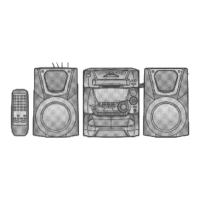
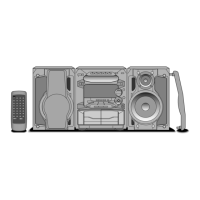
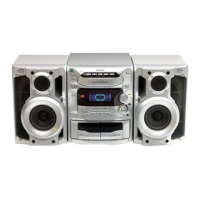


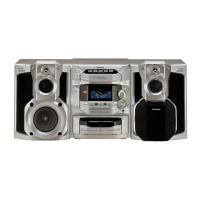
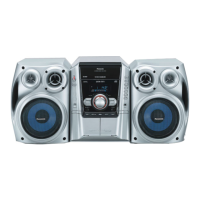
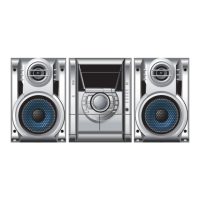
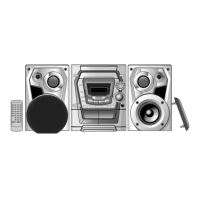

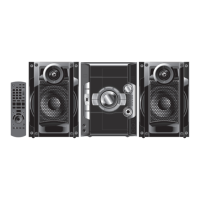
